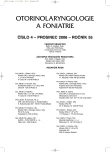-
Medical journals
- Career
Traumatic Perforation of Eardrum
Authors: V. Haas; P. Čelakovský; L. Školoudík; J. Dršata; J. Vokurka
Authors‘ workplace: Klinika ušní, nosní, krční LF UK a FN Hradec Králové přednosta doc. MUDr. J. Vokurka, CSc.
Published in: Otorinolaryngol Foniatr, 55, 2006, No. 4, pp. 189-192.
Category: Original Article
Overview
Traumatic perforation (rupture) of eardrum belongs to frequent injuries of middle ear, caused by direct or indirect injury (e.g. pressure wave). One hundred and ninety five patients have been treated at the Otolaryngological Clinic of Faculty Hospital in Hradec Kralove during 2000-2005 for the diagnosis of eardrum perforation. The method of retrospective analysis was used for processing the data of 98 patients observed at least 6 months after the injury, obtained from medical documentation – medical records and outpatient records.
The patients were examined by otoscopy, otomicroscopy or otoendoscopy. Audiogram was made in all patients and audiometric examination was repeated during the period of observation. In some patients, tympanometry was performed with the aim to examine conditions on the eardrum and in middle ear cavity after morphologically cured up eardrum as well as for the evaluation of ventilation function of Eustachian tube. Broad-spectrum antibiotics were used for systemic treatment in all cases. The patients who suffered from secretion from middle ear were also applied antibiotics locally as ear drops. The objective of the study was to demonstrate the effect of perforation coverage by prosthesis for healing of the eardrum. Te minor prosthesis was made from an adhesive from unwoven textile (Leukopor, Micropore), which is easier to manipulate than the traditionally used cigarette paper, since it is tougher and sticky on one side. The selection of perforation for coverage was dependent on their size and accessibility. We have investigated the following parameters: etiology of the injury, side dependence of the damage, time from the injury until healing of the perforation, dependence of healing of the perforation on the coverage with prosthesis and age of the patients.
In our group the perforation was covered with prosthesis in 48 patients, 4 perforations were covered partially due to poor accessibility and the perforation was left without coverage in 37 patients. The injury healed up in 85 patients and the perforation did not heal up in 12 subjects. Eleven patients underwent myringoplasty. Their eardrum did not heal up within half year after the injury. The average time period from the injury until healing proved to be 1.5 months, median age of the patients at the time of injury was 29 years with the range of 4-85 years. In our cohort we failed to demonstrate a statistically significant relationship of healing upon age of the patients, and an individual condition of eardrum – previous inflammations, traumatic injuries or operations – may exert higher effect. These relations were not evaluated in the study, though. The coverage of the perforation with the small prosthesis did not significantly improve healing of the eardrum. In spite of that we consider the coverage of traumatic perforation with prosthesis as a favorable contribution, which brings about an immediate positive effect to the patients. It forms a mechanical barrier against penetration of water and infection into the middle ear and improves hearing is its deterioration has been caused by perforation.Key words:
trauma, perforation, eardrum, myringoplasty.
Labels
Audiology Paediatric ENT ENT (Otorhinolaryngology)
Article was published inOtorhinolaryngology and Phoniatrics

2006 Issue 4-
All articles in this issue
- Traumatic Perforation of Eardrum
- Possibilities of 24-hour pH-metry of Upper Esophagus in the Diagnostics of Esophageal-Pharyngeal Reflux
- The Standpoint of Surgeon on Preservation of Facial Nerve Function in Removing of Vestibular Schwannoma by Translabyrinth Approach
- The Standpoint of the Monitoring Specialist on Preservation of Facial Nerve Function in Removing of Vestibular Schwannoma by Translabyrinth Approach
- Following the Interaction between Parent and Child in the Treatment of Speech Disorders
- Clinical Anatomy of the Epitympanum
- Shooting Combined Injury of Respiratory and Swallowing Pathways
- Extraabdominal Desmoid, Report of Two Cases
- Extracranial Meningioma
- Lipoblastoma - a Rare Parapharyngeal Mass in Childhood
- Herpes Zoster Oticus
- Otorhinolaryngology and Phoniatrics
- Journal archive
- Current issue
- Online only
- About the journal
Most read in this issue- Traumatic Perforation of Eardrum
- Herpes Zoster Oticus
- Clinical Anatomy of the Epitympanum
- Possibilities of 24-hour pH-metry of Upper Esophagus in the Diagnostics of Esophageal-Pharyngeal Reflux
Login#ADS_BOTTOM_SCRIPTS#Forgotten passwordEnter the email address that you registered with. We will send you instructions on how to set a new password.
- Career

